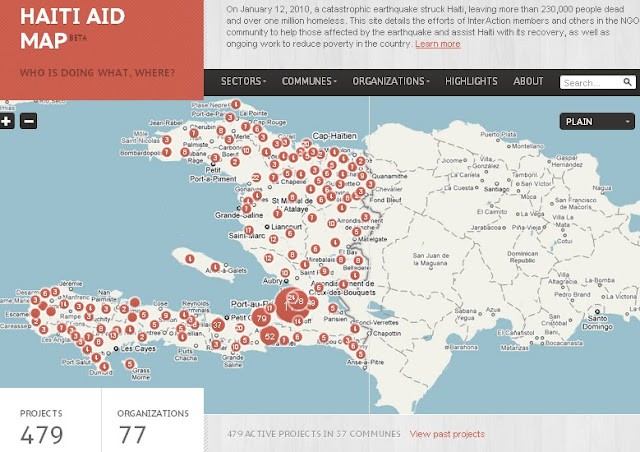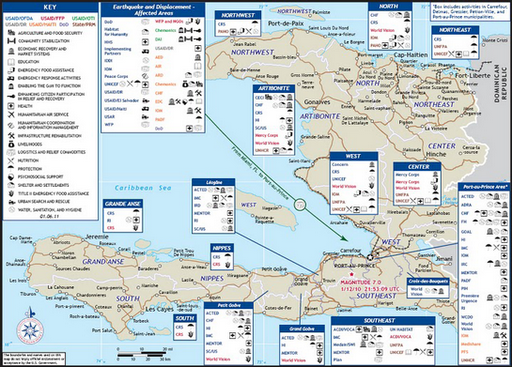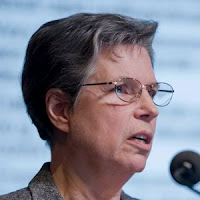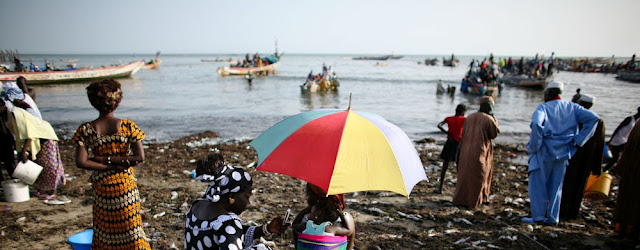-
Water Security, Nonproliferation, and Aid Shocks in the Middle East
›In a report sponsored by the Stanley Foundation and the Stimson Center, authors Brian Finlay, Johan Bergenas, and Veronica Tessler discuss the implications of what a growing population and dwindling water supply will have on the people and governments of the Middle East. In the report, titled “Beyond Boundaries in the Middle East: Leveraging Nonproliferation Assistance to Address Security/Development Needs with Resolution 1540,” the authors point out that while the Middle East has six percent of the world’s population, it has only 0.7 percent of the world’s fresh water resources. This supply is expected to be halved in the coming decades due to “rapid population growth and increased standards of living in urban areas.” To make up for this shortfall, governments are turning to nuclear-powered desalination technology, which poses risks to the nonproliferation movement and the safety and stability of the region. (Editor’s note: for more on water as a strategic resource in the Middle East, see CSIS’ latest report.)
A recent study by Richard Nielsen, Michael Findley, Zachary Davis, Tara Candland, and Daniel Nielson from Bringham Young University examines the relationship of severe decreases in foreign aid to inciting violence among rebels in recipient countries. The study, “Foreign Aid Shocks as a Cause of Violent Armed Conflict”, examines aid shocks in 139 countries from 1981-2005. The authors find that when a donor country cuts off or suddenly limits aid due to economic or political reasons, this volatility upsets the status quo and gives strength to rebel groups who play upon the government’s inability to deliver adequate resources to the population. Instead of a sudden or sharp withdrawal in aid, Nielsen et al conclude that “if donors decide to remove aid, they should do so gradually over time because sudden large decreases in aid could be deadly.” -
Mapping the “Republic of NGOs” in Haiti
›One year after the devastating earthquake that hit Haiti, InterAction has teamed up with the U.S. Chamber of Commerce’s Business Civic Leadership Center and FedEx to launch the Haiti Aid Map, an interactive visual mapping platform of individual aid projects being conducted in Haiti. The goals of the map are to increase aid transparency, facilitate partnerships, and help NGOs and others better coordinate and allocate resources to aid relief and reconstruction efforts.
With an estimated 10,000 NGOs operating on the ground – the second largest per capita in the world – Haiti has been referred to as “a republic of NGOs.” The Haiti Aid Map is an effort to help the humanitarian community – which has been criticized for lack of accountability, poor transparency, and corruption – better coordinate its response.
The map features 479 projects being operated all over the country by 77 local and international NGOs, most of which are InterAction members. Projects can be browsed by location, sector, or organization and include information on project donors, budgets, timelines, and the number of people reached by the project.
While InterAction’s map covers their donors’ response, it leaves out the thousands of government and other NGO projects being conducted in Haiti. USAID recently released a map of U.S. government projects in Haiti (see right) by sector and location.
“The goal is not to rebuild Haiti but to build a different Haiti,” said Sam Worthington, President and CEO of InterAction, speaking exactly one year after the earthquake struck at the map’s formal launch this month. “The relief effort will still be here a year from now.” The goal of the map will be to help coordinate activities as reconstruction continues in the future.
The map is the first part of a larger mapping platform, called the NGO Aid Map, which will include not only the Haiti aid map but also projects working on food security in other developing countries. The food security map is due to be launched in March 2011.
Sources: Clinton Foundation, InterAction, NPR, ReliefWeb, USIP.
Image Credit: Adapted from Haiti Aid Map. -
Linden Ellis, ChinaDialogue
China’s Biggest Environmental Stories of 2010/11
›January 21, 2011 // By Wilson Center Staff The original version of this post first appeared on ChinaDialogue’s The Daily Planet blog, December 23, 2010.
The original version of this post first appeared on ChinaDialogue’s The Daily Planet blog, December 23, 2010.
Last month I spent a few days in Washington, DC meeting mostly with people working on U.S.-China environmental relations. Among others, I met with Jennifer Turner, director of the China Environment Forum at the Wilson Center (and my former boss), and we had an exciting conversation about the biggest China environmental stories covered in the United States in 2010, and what we hope to see in 2011. I was inspired to write this post based on our conversation. This is of course neither definitive nor exhaustive, but merely my perspective on how things look from Washington.China Is Winning the Clean Energy Race. Energy was the big story in 2010. Studies show that the United States will need to renovate or retire virtually all of its power plants by 2050, and China must build a modern energy sector to serve a growing population. Both countries emphasized their intentions to build a clean energy economy in 2010 and almost immediately competition was dubbed a “race.” Soon after it was declared a two-party race, it became evident that China was winning.
China’s clean energy investment is two times greater than that of the United States, according to a Pew Charitable Trust report published last year. The news has centered upon China’s ability to make sweeping changes to domestic energy markets, in stark contrast to the United States’ inability to pass climate legislation. Most notably in 2010, China passed a regulation requiring that a percentage of all electric company profits be used for energy efficiency every year.
Energy “Co-op-etion.” Perhaps as a response to fears of “losing” the energy race, public opinion in the United States focused on new and existing energy cooperation and on market fairness. The U.S.-China Clean Energy Research Center, signed in 2009, was officially launched in 2010 and is likely to formalize a great deal of on-going cooperation on energy between the United States and China. In December, Jonathan Silver, Executive Director of the U.S. Department of Energy’s Loan Guarantee Program, spoke at a conference in San Francisco and described the developing energy relationship between China and the United States as “co-op-etition” – the two countries have complementary markets and a lot to learn from each other but will compete in U.S., Chinese, and international markets to sell clean technologies.
Concerns about the fairness of the market – initially because of changes in China’s government procurement laws discriminating against foreign clean technology companies – peaked with the U.S. Steel Workers’ petition in October. Americans are concerned that their technologies will suffer in the international market because of Chinese clean technology subsidies.
China “Ruined” Copenhagen. Perception that China ruined Copenhagen dominated the U.S. news early in the year but was softened by a more positive outlook following Cancun. Anxiety in Washington, DC regarding the accuracy of China’s CO2 data colored many debates on American participation in international climate negotiations all year.
Oil and Rare Earths. The oil spill in Dalian in July made big news in the United States as it came in the wake of the BP oil spill in the Gulf of Mexico. Many comparisons were made, despite the enormous difference in scale between the two incidents. Rare earth elements (the spine of the clean technology industry) were another major concern that arose in 2010 in Washington. Many of America’s rare earth mines were shuttered decades ago when Chinese mines were able to produce more affordably. This year, China began restricting rare earth exports, at least partially for environmental reasons, forcing the United States to consider reopening many of its mines and how to deal domestically with the environmental effects of those mines.
In 2011 I hope that interest in China’s environment will continue in the United States, but I expect that we will see less on renewables, as stimulus money runs thin, and rising concern for more traditional pollutants and basic environmental governance in China (especially regarding water and air pollutants).
The 12th Five-Year Plan. Set to be released early 2011, the 12 Five-Year Plan will initially dominate energy stories as it outlines how China will meet its ambitious energy intensity targets. I expect nuclear energy will replace wind and solar as the big stories in 2011. Nuclear liability should be addressed in China in 2011, as it was in India in 2010. Because of the close energy business ties between China and the United States, liability laws in China are likely to be more sympathetic to the needs of American companies than India’s recent law, which exposes nuclear components suppliers to unlimited liability.
Soil Pollution Prevention and Remediation. China’s soil pollution survey was completed in 2009 and the draft Provisional Rules on Environmental Management of the Soil of Contaminated Sites was released by the Ministry of Environmental Protection for comment in December 2009. The problem is huge and significant in China’s development and construction boom, and little data has been publicly released from the survey. I expect that in 2011, we will start to see active management and enforcement, at least in major cities.
Water Quality and Quantity. Water has and will likely continue to be, the greatest environmental concern in China and abroad, given its transboundary nature. Turner suggests we will see more on control of and attention to nitrogen pollution in China’s waterways in 2011.
To chime in with your comments on what you feel were the biggest stories of 2010 and what you predict will dominate 2011, be sure to let us know below or on ChinaDialogue.
Linden Ellis is the U.S. project director of ChinaDialogue and a former project assistant for the Wilson Center’s China Environment Forum.
Sources: Asia Society, ChinaDialogue, The New York Times, Pew Charitable Trust.
Photo Credit: “Factory in Inner Mongolia,” courtesy of flickr user Bert van Dijk. -
Elizabeth Malone on Climate Change and Glacial Melt in High Asia
› “There’s nothing more iconic, I think, about the climate change issue than glaciers,” says Elizabeth Malone, senior research scientist at the Joint Global Change Research Institute and Pacific Northwest National Laboratory. Malone served as the technical lead on “Changing Glaciers and Hydrology in Asia: Addressing Vulnerability to Glacier Melt Impacts,” a USAID report released in late 2010 that explores the linkages between climate change, demographic change, and glacier melt in the Himalayas and other nearby mountain systems.
“There’s nothing more iconic, I think, about the climate change issue than glaciers,” says Elizabeth Malone, senior research scientist at the Joint Global Change Research Institute and Pacific Northwest National Laboratory. Malone served as the technical lead on “Changing Glaciers and Hydrology in Asia: Addressing Vulnerability to Glacier Melt Impacts,” a USAID report released in late 2010 that explores the linkages between climate change, demographic change, and glacier melt in the Himalayas and other nearby mountain systems.
Describing glaciers as “transboundary in the largest sense,” Malone points out that meltwater from High Asian glaciers feeds many of the region’s largest rivers, including the Indus, Ganges, Tsangpo-Brahmaputra, and Mekong. While glacial melt does not necessarily constitute a large percentage of those rivers’ downstream flow volume, concern persists that continued rapid glacial melt induced by climate change could eventually impact water availability and food security in densely populated areas of South and East Asia.
Rapid demographic change has potentially factored into accelerated glacial melt, even though the connection may not be a direct one, Malone adds.
Atmospheric pollution generated by growing populations contributes to global warming, while black carbon emissions from cooking and home heating can eventually settle on glacial ice fields, accelerating melt rates. Given such cause-and-effect relationships, Malone says that rapid population growth and the continued retreat of High Asian glaciers are “two problems that seem distant,” yet “are indeed very related.”
The “Pop Audio” series is also available as podcasts on iTunes. -
Watch: Amy Webb Girard on Integrated Development Strategies for Improved Women’s Nutrition
›“When women become pregnant…their nutrient needs shoot through the roof,” said Amy Webb Girard of Emory University’s School of Public Health in this interview with ECSP and the Global Health Initiative. Girard explains that under-nutrition is a major problem for women – especially pregnant women – in resource-poor settings.
“For example, iron requirements almost double during the course of pregnancy, but iron is one of those nutrients that are really difficult to get,” Girard explained. Meat is not readily available in many developing countries and the iron in non-meat foods is not absorbed as completely. As a result, “women by and large are unable to meet those nutrient needs,” she said.
Fortunately, there is “an arsenal of nutritional interventions available,” noted Girard, including micro-nutrient supplements, behavior change strategies, and integrated facility- and community-based delivery methods.
“Additionally I think it’s very important that we also look at food production. This is a key, key thing,” said Girard. “Women who are able to produce their own foods [and] households that can produce their own foods have greater food security.”
“A lot of these agricultural strategies serve double purposes,” Girard said. “They not only increase the available food and the quality of that food, they improve women’s livelihoods, they give them a source of income, they give them – as some studies have shown – greater ability to negotiate within their own households for how money should be spent [and] whether they should access care or not. So they actually empower women in ways beyond nutrition.” -
National Geographic’s Population Seven Billion
›The short feature above and accompanying cover article in the January 2011 issue launch National Geographic’s seven-part year-long series examining global population. The world is set to hit seven billion this year, according to current UN projections, and may reach nine billion by 2045.
The authors point out that today, 13 percent of people don’t have access to clean water globally and 38 percent lack adequate sanitation. Nearly one billion people have inadequate nutrition. Natural resources are strained. Is reducing population growth the key to addressing these problems?
Not according to Robert Kuznig, author of National Geographic’s lead article, who writes that “fixating on population numbers is not the best way to confront the future…the problem that needs solving is poverty and lack of infrastructure, not overpopulation.”
“The most aggressive population control program imaginable will not save Bangladesh from sea-level rise, Rwanda from another genocide, or all of us from our enormous environmental problems,” writes Kuznig. Speaking on NPR’s Talk of the Nation last week, he reiterated this message, saying global problems “have to be tackled whether we’re eight billion people on Earth, or seven, or nine, and the scale for them is large in any case.”
Instead, the challenge is simultaneously addressing poverty, health, and education while reducing our environmental impact, says Kuznig.
“You don’t have to impose prescriptive policies for population growth, but basically if you can help people develop a nice, comfortable lifestyle and give them the access to medical care and so on, they can do it themselves,” said Richard Harris, a science correspondent for NPR, speaking with Kuznig on Talk of the Nation.
Kuznig’s article highlights the Indian state of Kerala, where thanks to state investments in health and education, 90 percent of women in the state can read (the highest rate in India) and the fertility rate has dropped to 1.7 births per woman. One reason for this is that educated girls have children later and are more open to and aware of contraceptive options.
Whither Family Planning?
In a post on Kuznig’s piece, Andrew Revkin, of The New York Times’ Dot Earth blog, points to The New Security Beat’s recent interview with Joel E. Cohen about the crucial role of education in reducing the impact of population growth. Cohen asks: “Is it too many people or is it too few people? The truth is, both are real problems, and the fortunate thing is that we have enough information to do much better in addressing both of those problems than we are doing – we may not have silver bullets, but we’re not using the knowledge we have.”
Although the National Geographic article and video emphasize the connections between poverty reduction, health, education, and population growth, both give short shrift to family planning. It’s true that fertility is shrinking in many places, and global average fertility will likely reach replacement levels by 2030, but parts of the world – like essentially all of sub-Saharan Africa for example – still have very high rates of fertility (over five) and a high unmet demand for family planning. Globally, it is estimated that 215 million women in developing countries want to avoid pregnancy but are not using effective contraception.
Development should help reduce these levels in time, but without continued funding for reproductive health services and family planning supplies, the declining trends that Kurznig cites, which are based on some potentially problematic assumptions, are unlikely to continue.
As Kuznig told NPR, “you need birth-control methods to be available, and you need the people to have the mindset that allows them to want to use them.”
At ECSP’s “Dialogue on Managing the Planet” session yesterday at the Wilson Center, National Geographic Executive Editor Dennis Dimick urged the audience to “stay tuned – you can’t comprehensively address an issue as global and as huge as this in one article, and within this series later in the year we will talk about [family planning] very specifically.” Needless to say, I look forward to seeing it, as addressing the unmet need for family planning is a crucial part of any comprehensive effort to reduce population growth and improve environmental, social, and health outcomes.
Sources: Center for Global Development, Dot Earth, NPR, Population Reference Bureau, World Bank.
Video Credit: “7 Billion, National Geographic Magazine,” courtesy of National Geographic. -
In FOCUS: To Get HELP, Add Livelihoods to Population, Health, and Environment
›January 20, 2011 // By Wilson Center StaffProponents of integrated development have always faced significant barriers, but with a new focus on international aid from the Obama administration, the tide may be turning. To fully harness this momentum, Gib Clarke argues in a new ECSP brief that the population-health-environment (PHE) community must solidify its research base, reach out to new partners, and push for flexible funding and programming.
In “Helping Hands: A Livelihood Approach to Population, Health, and Environment Programs,” he writes that PHE programs should also add livelihoods (i.e., ways to make a living) as a critical element. He suggests such programs adopt a new moniker: “HELP” – Health, Environment, Livelihoods, and Population.
“Helping Hands” comes at a time when the integrated approach is being touted at the highest levels:“We cannot simply confront individual preventable illnesses in isolation. The world is interconnected, and that demands an integrated approach to global health,” said President Barack Obama in May 2009, echoing what population-health-environment (PHE) practitioners have long argued: Integrated lives with integrated problems require integrated solutions. Proponents of integration face significant barriers: lack of funding, programmatic silos, and policy disinterest.
While the Administration’s newest development efforts (see, e.g., Feed the Future Initiative, Global Health Initiative, and release of the QDDR) all recognize the power of integration, the degree to which these initiatives will operate across sectors remains to be seen. Drawing on interviews with leading experts, Clarke outlines the continuing challenges to implementing more integrated PHE programs and offers four recommendations for overcoming them:
“Given the strong base of existing and recent PHE programs, the PHE community is well-positioned to work with lead partners in Obama’s Global Health Initiative, climate change adaptation efforts, food security programs, and other upcoming crosscutting work,” concludes Clarke, who is currently director of planning and development at Interfaith Community Health Center in Bellingham, Washington. For example, USAID Administrator Rajiv Shah stated that the Feed the Future program would be closely integrating its objectives with the Global Health Initiative – a potential opportunity for PHE programs that offer both health benefits and food security.- The PHE community should adopt a new name that highlights the all-important livelihood component, such as “HELP Plus.”
- PHE programs need to gather data and conduct operational research to justify the claims of the PHE field.
- The PHE community needs to “agree to disagree” on the issue of scaling up integrated programs.
- PHE programs should seek funding from a diverse array of donors.
“This increased interest in integration may also be the best opportunity for finding new funding, fostering replication, and scaling up. It is a promising moment for integrated approaches, whether we call them PHE, HELP Plus, or some other acronym,” writes Clarke.
“Helping Hands: A Livelihood Approach to Population, Health, and Environment Programs” along with previous FOCUS issues are available on ECSP’s publications page.
Image Credit: From the cover of “Helping Hands: A Livelihood Approach to Population, Health, and Environment Programs,” courtesy of the Wilson Center. -
Apply Now for the Compton Foundation/PRB International Fellowship
Doing Research on Reproductive Health, Environment, and Security?
›January 19, 2011 // By Hannah Marqusee
The Population Reference Bureau and Compton Foundation’s International Fellows Program deadline is rapidly approaching on January 24. The fellowship is for students from sub-Saharan Africa or Latin America seeking to affect policy and/or improve the effectiveness of population, family planning, and reproductive health programs in the developing world. Master’s students may be awarded up to $10,000 and PhD students up to $20,000 to perform capstone/internship work or dissertation research on the intersection between reproductive health, the environment, and security.
2010 Compton/PRB Fellow Kennedy Maring, a Ugandan student at UNC Chapel Hill, spent a year researching the feasibility of integrating family planning services into HIV/AIDS programs in Masindi, Uganda, in order to address high rates of mother-to-child transmission of HIV. Maring interviewed 182 pregnant women and 11 health providers in Masindi, and found that while more women in the area understood that HIV could be passed from mother to child than the national average, few were using available services such as HIV counseling or family planning. Her research resulted in many recommendations to improve prevention of HIV transmission and use of family planning, including: integrate family planning into HIV prevention; train more health providers; involve men in reproductive health care; encourage hospital delivery; bring services to the people; and provide free breast milk supplements.
Patrick Kipalu, an American University student from the Democratic Republic of Congo (DRC), traveled deep into his country’s forests to interview indigenous people about their perspective on and awareness of climate change, deforestation, and mitigation programs such as the UN Reducing Emissions from Deforestation and Forest Degradation program (REDD). Kipalu’s research showed that weak forestry governance, widespread ignorance of forestry laws, corruption, and lack of indigenous community participation, among other challenges, will make successful implementation of REDD difficult. If the current style of forestry management in the DRC continues, REDD will only provide incentives for more corruption and deforestation, he found. In this highly centralized government process, the government, logging companies, and other powerful stakeholders will reap all the benefits without any revenue going back to benefit indigenous forest communities.
How to Apply
2011 fellowship applications are being accepted until January 24, 2011. To apply, send a completed application form, curriculum vitae, cover letter, transcript, abstract of proposed research, budget, and two letters of recommendation to Dr. Ashley Frost at afrost@prb.org. Master’s students must also provide a letter from the organization where their capstone/internship will take place, and Ph.D. students must provide proof of an approved research proposal.
For full instructions, visit the fellowship site on PRB.
Photo Credit: Adapted from “photoshot,” courtesy of flickr user hippolyte.
Yearly archive for 2011.
Show all posts












